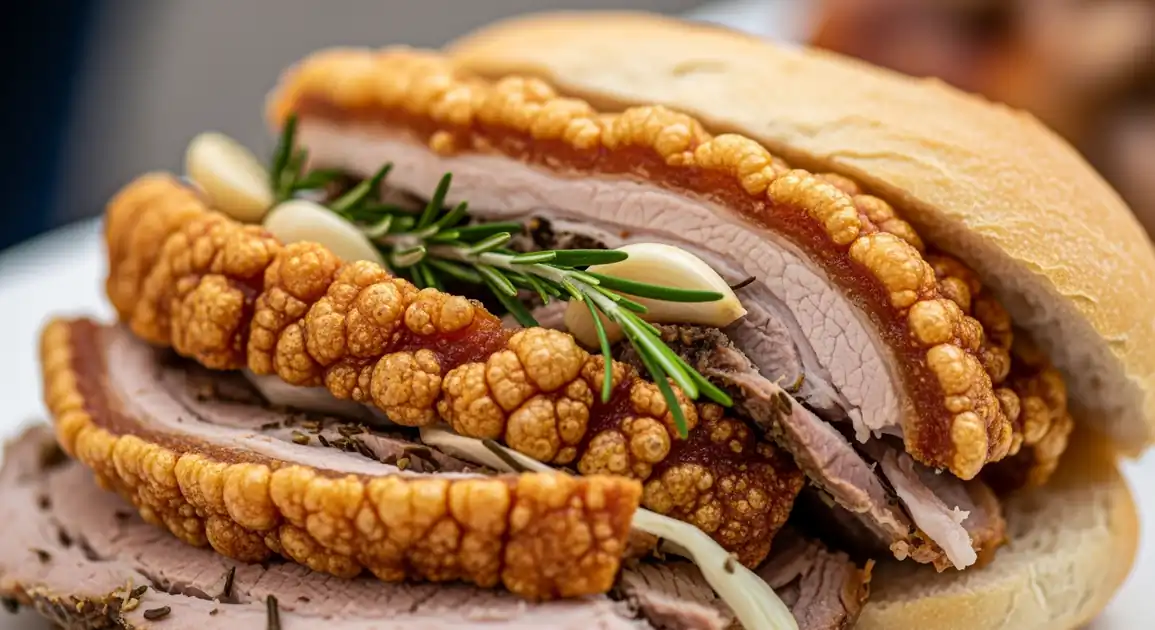Porchetta
Porchetta

Description
While perhaps less ubiquitous than in Rome, excellent porchetta can certainly be found in Florence. Look for it at market stalls, particularly Mercato Centrale, specialized 'lampredottai' who might also sell porchetta, and some traditional trattorias. Tuscan porchetta often emphasizes rosemary and garlic in its seasoning.
Dietary Information
Serving information
Serving style
Commonly served as a panino. Also available sliced by weight at market butcher stalls.
Quick facts
Market hours (generally morning to early/mid-afternoon). Food court hours longer. Restaurant hours vary.
Safety Tips
What to Look For
-
Vendor slices meat fresh from the whole roast
Ensures freshness and avoids risks associated with pre-sliced meat sitting out.
-
Meat appears moist and skin looks crispy
Visual cues for quality and proper cooking/holding. Avoid porchetta that looks dry or has soggy skin.
-
Clean vendor setup (truck/stall, knives, board)
Good hygiene practices are essential for food safety.
-
High customer turnover
Indicates the porchetta is fresh and popular, reducing the time it sits around.
-
Porchetta kept warm (if applicable)
While often served room temp shortly after slicing, if it's meant to be hot, ensure it's held properly.
What to avoid
-
Pre-sliced porchetta sitting out for long periods
Increases risk of bacterial growth and loss of quality (dry meat, soggy skin).
-
Meat looks visibly dry, grey, or discolored
Suggests poor quality, overcooking, or being old.
-
Soggy, pale, or leathery skin
Indicates improper roasting or storage.
-
Dirty vendor area, knife, or cutting board
High risk of cross-contamination.
-
Unpleasant or 'off' smell
Indicates spoilage; do not consume.
Price information
Price range
Budget tips
- Mercato Centrale stalls offer competitive pricing.
- Look for vendors slightly away from the busiest Duomo area.
- A porchetta panino is a great value lunch option.
Value indicators
- Vendor slices from a whole roast.
- Crispy, well-rendered skin.
- Meat looks moist and flavorful, possibly seasoned heavily with rosemary.
- Served in good quality Tuscan bread (like 'schiacciata' or a crusty roll).
Where to Find This Dish
Mercato Centrale (Central Market)
The ground floor hosts butcher stalls selling porchetta by weight, and the upstairs food court often has vendors selling panini.
Ground floor butcher section, Upstairs food hall
Market hours (approx. 8 AM - 2 PM ground floor, later for food court)
Mercato di Sant'Ambrogio
Another traditional market where you might find porchetta vendors or butchers selling it.
Sant'Ambrogio market building
Market hours (Morning to early afternoon)
Street Vendors / Kiosks
Less common than lampredotto kiosks, but occasional dedicated porchetta vendors can be found, sometimes near markets or squares.
Requires searching or local knowledge
Lunchtime
Traditional Trattorias
Some Florentine trattorias might offer roasted pork ('Arista al forno' is different, but some may offer porchetta) as a main course.
Local trattorias, check menus
Lunch, Dinner
Vendor Tips
- Visit Mercato Centrale for reliable options, both sliced and in panini.
- Ask if the seasoning uses rosemary ('rosmarino') for the typical Tuscan style.
- Compare vendors within the market if multiple options exist.
- Be clear if you want just the meat ('solo carne') or a sandwich ('un panino').
How to Order
Regional Variations
-
Tuscan Herb Profile
(Profilo Aromatico Toscano)
Rosemary ('rosmarino') and garlic are often the dominant seasonings in Tuscan porchetta, compared to wild fennel elsewhere.
-
Bread Pairing
(Abbinamento con Pane)
May be served in local Tuscan breads like 'schiacciata' or 'pane toscano'.
Cultural context
History
Porchetta boasts ancient origins, potentially dating back to Etruscan or Roman times in Central Italy. Its modern form is strongly associated with regions like Lazio (particularly the town of Ariccia, which holds IGP status for its specific recipe), Umbria, Tuscany, and Abruzzo. Historically a festive dish prepared for celebrations and holidays, porchetta became popular street food sold from mobile vans and market stalls, especially in the post-war era, providing affordable, flavorful sustenance. Today, it remains a beloved staple across Italy, with regional variations in seasoning.
Local significance
While Tuscany has its own roast pork traditions ('Arista'), porchetta is also appreciated, often reflecting the region's focus on high-quality pork and simpler seasoning (rosemary/garlic).
Eating customs
- Often eaten amidst the bustle of the market.
- Pairs well with Tuscan red wine (Chianti).
- Schiacciata bread might be used for the panino instead of a roll.